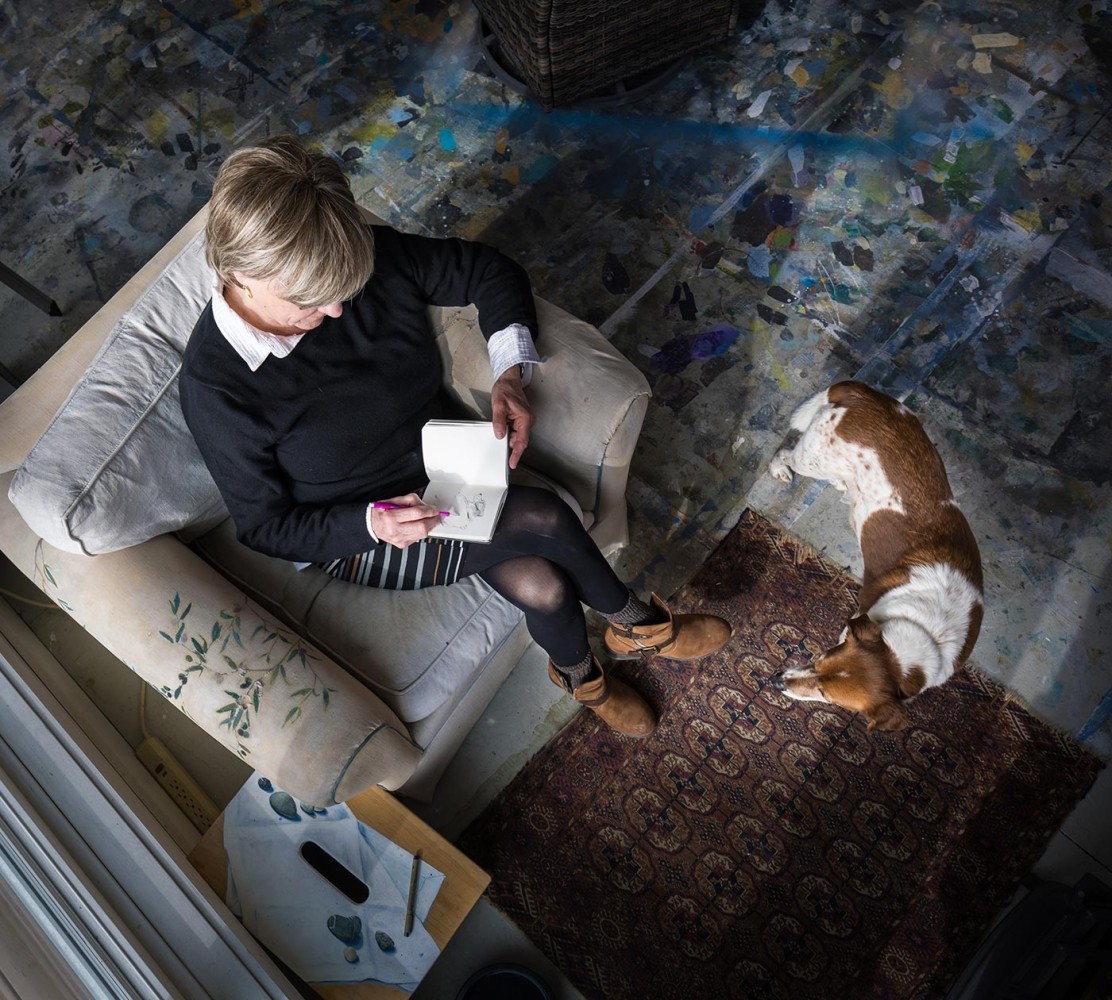
Colorful splotches of paint cover the floor of artist Adelaide Murphy Tyrol’s studio in Marshfield, Vermont. Paint-splattered buckets are stacked beneath a large sink. Brushes of various sizes hang from hooks along the wall or stand in small bins, bristles up. A small array of airbrush guns lies at the ready. Drawers and open shelves hold other tools and materials – different types of paper, pens and pencils, delicate sheets of gold leaf.
Amid it all is a sense of homey calm and order. There’s a small heating stove in one corner, along with a cozy armchair and a throw rug, where Henry the dog snoozes. Large windows line one entire wall, welcoming an abundance of natural light. Against this wall stands a tall, simple wooden table.
It is here that Tyrol creates the illustrations that have graced Northern Woodlands magazine and the weekly ecology series, The Outside Story, for the past three decades. From her worktable, Tyrol can look over the pond that sits a stone’s throw from her studio, and to the fields and forest beyond. A telescope next to the table offers close-up viewing of far-away things. Often, she finds inspiration for her illustrations from this view of her home landscape.
For one of the first illustrations Tyrol made for the magazine, however, she had a live subject.
“Ginny Barlow (cofounder of Vermont Woodlands, which became Northern Woodlands in 1999) called me and said, ‘We need an illustration of a wood frog. Would you like me to bring you one?’” said Tyrol. “So, she went into the woods and got a wood frog and drove it up to me from Corinth. We had a really nice talk, and I remember, as Ginny was leaving, she turned around and said, ‘You can let it go when you’re done.’”
Tyrol followed that instruction, releasing the frog into the woods once she had drawn it.
Since her first illustrations for the magazine in 1998, Tyrol has created close to 2,000 others. Her work for the Center for Northern Woodlands Education now includes providing weekly images to accompany The Outside Story, supported through the Wellborn Ecology Fund of New Hampshire Charitable Foundation, as well as illustrations for the magazine’s Invertebrate Bestiary and Seasonal Notes columns. She also writes the Art Review page for each issue. A few of her paintings, on loan, have pride of place in Northern Woodlands’ office in Lyme, New Hampshire.
While Northern Woodlands readers are intimately familiar with Tyrol’s natural history illustrations, her work as an artist has reached far beyond her central Vermont home and studio.
From Vermont to New York City – and Back Again
Tyrol’s artistic inspiration began in high school in western Massachusetts, where her art teacher was renowned artist and wood engraver Barry Moser.

“I was a senior in high school when I took a class with him,” Tyrol said. “He’s an amazing artist. He completely changed me. It was really from Barry Moser that I wanted to work in black and white and work with ink. He just has a very dramatic way of doing things that was unusual. He was my mentor in graduate school, and he remains a very, very close friend.”
After high school, Tyrol attended University of Vermont, majoring in art and English. Then she studied illustration at Parson’s School of Design in New York City.
“At that time, there were advertising agencies looking for artists, and I thought maybe I’d go in that direction,” said Tyrol. “But I met this person in art school who had a job washing buckets for a backdrop painter.”
The acquaintance asked Tyrol to fill in for her while she was away for a few weeks, which Tyrol begrudgingly agreed to do. That temporary bucket-washing gig turned into a career with the company, Oliphant Studio.
“I started working with Sarah Oliphant, who in 1981 became my business partner, painting big backdrops,” Tyrol said. “I was a trained artist, and Sarah recognized that.”
Since 1978, the company has painted backdrops used in advertising, photo shoots, and film and television productions. Sometimes subtle, sometimes elaborate, these giant backdrops – painted on canvas or muslin or actual building walls – have framed an impressive roster of A-list celebrities. Clients have included such legendary personalities as photographer Annie Leibovitz, fashion designer Oscar de la Renta, musicians from Mariah Carey to the Beastie Boys, and publications ranging from The New York Times to National Geographic.
In 1986, Tyrol decided to return to the Green Mountain State and bought the house where she lives now, in the hills not far from Montpelier, amid a neighborhood of dairy farms. A stone wall lines the long drive, apple trees dot the yard, and a simple wooden swing hangs from a tree branch – waiting, perhaps, for her two grandchildren to grow big enough to climb onto it. The commute from house to studio involves a short walk across the yard.
“The reason my studio is so big is because it was built for creating these huge, 10-by-20-foot paintings,” said Tyrol, who retired from Oliphant Studio in 2023. The myriad paint smears on the floor are remnants of those many years of work and countless backdrops painted here. “I’d staple the canvas to the floor. I had big buckets of paint, and I painted standing up with a brush attached to a long pole. I’d paint a big drop on the canvas, roll it up on a tube, put it in a PVC pipe, and ship it to New York.”
Around the same time that she joined Oliphant Studio, Tyrol also began creating natural history illustrations. Decades into her career as an artist, in 2007, she entered a low-residency MFA program at The Art Institute of Boston, spending brief periods of time in the city attending lectures and intensive classes, interspersed by long stretches at the home studio working on her own art.
Although Vermont is home, Tyrol’s time in cityscapes has been essential to her development as an artist. She prizes her time in New York, especially.
“I love New York. It’s familiar to me and fun. If you know it – it’s so dynamic,” said Tyrol. “There’s so much happening there, especially in the arts. I couldn’t really have had a career that supported me up here. I don’t think I could have done that.”
Huge or Tiny – It’s All in the Detail
Eventually, Tyrol settled into what she categorizes into three types of work: the giant backdrops, natural history illustrations, and painting for gallery showings.
“It’s huge or tiny,” Tyrol said of her work. “But it’s the same thing, in a way. When you’re drawing, you’re using your wrist. And when you’re standing up and working on these big paintings, it’s more your shoulder. The gallery work is almost a perfect amalgamation of natural history illustration and painting really, really large. The subject matter is usually natural history–related, but the painting is quite broad and loose.”
In recent years, some of her gallery work has related to endangered species. Tyrol and another Vermont artist, Linda Mirabile, have co-curated two exhibitions – On the Brink: Artists Take Action in 2018 and A Critical Balance: Artists Take Action in 2019 – featuring endangered species from around the world.
When it comes to her work for Northern Woodlands, Tyrol strives to make each illustration accurate, but also eye-catching.
“I want to get it right, but I want to get people’s attention. For instance,” she said, pointing to an Outside Story illustration of a fishing spider nearly covering an entire human hand, “this huge fishing spider – I really want to get people, when they’re looking through the paper, to stop. And that really shows you how big that spider is. I want to stop people so they look.”
Although the subject matter changes weekly, Tyrol’s process remains similar. Once she’s received the week’s essay, she prints it out and sits in the chair by the windows. She reads the piece and picks out details she thinks may work to illustrate the subject.
“I look for interesting things that will catch people’s eye – and give them the information that the author is trying to give,” she said. “I really, really enjoy it, because I learn so much.” Often, she turns to her collection of natural history books and to the internet to seek out details that will help her depict the species or phenomenon featured in an essay.
“Not all the illustrations are painted. They’re all different. They’re on different materials,” Tyrol said. “I use pencil, pen, different types of ink. And different types of paper. Sometimes I draw, and I hate what I did, so I start again.”
Once she’s finished an illustration on 8-by-10-inch paper, she scans it, emails it to Northern Woodlands, then slides the original into a cabinet of drawers in her studio. These are labeled in general terms: Mammals, Birds, Weather, Insects, and, of course, Trees.
“I do the drawing the best I can do, I scan it, and I put it in a drawer,” she said. “That’s the life of it. These drawers here contain all the drawings I’ve done for Northern Woodlands and The Outside Story. They’re just loaded.”
Artist as Teacher
Whether it’s attracting newspaper readers to an Outside Story article or introducing magazine subscribers to a new artist through the Art Review column, Tyrol is always looking to share knowledge and insight – and to keep learning. She enjoys frequent conversations with artist Susan Abbott, who rents work space in the barn adjacent to Tyrol’s studio.
“We’re very different kinds of artists, but we bounce ideas off each other,” Tyrol said. “She was a mentor for me during my graduate program. She really knows art history. And we’ll go out to dinner and talk about art.”
Tyrol also acts as a mentor to a 17-year-old girl, now a senior in high school. “For seven years we’ve been getting together once a week,” she said. “It has been the most wonderful relationship. We used to come down here and paint all the time. But now we paint at the kitchen table, and we’re just talking. We’re talking and painting and talking. A lot of it is life stuff. We just love spending time together.”
She also loves spending time in galleries and is always on the lookout for artists to highlight in her Art Review column.
“Whatever town I go to, I always want to go to the galleries anyway. Now I go with an eye to if they’re going to be interesting to Northern Woodlands readers,” she said. “I really try to have something different and interesting – either the technique or the materials. Oftentimes I’ll include a quote from somebody famous. I’m trying to teach people something – whether it’s about the Renaissance, or what Expressionism is, what Impressionism is. Because I think of the Northern Woodlands readership as mostly a science readership, not an art readership. I don’t know how many people read the column, but they look at the picture anyway.”
Inspiring people to look at the picture – whether it’s a photograph taken in front of one of the backdrops she’s created, a blue-eyed primate halfway across the world, or the intricate details of a white-throated sparrow’s plumage – is at the heart of Tyrol’s work. Huge and tiny, near and far, flora or fauna or landscape – Tyrol’s work connects with viewers far beyond the quiet hills of Vermont.
“It’s been a really, really fulfilling life for me,” she said, “and quite balanced.”


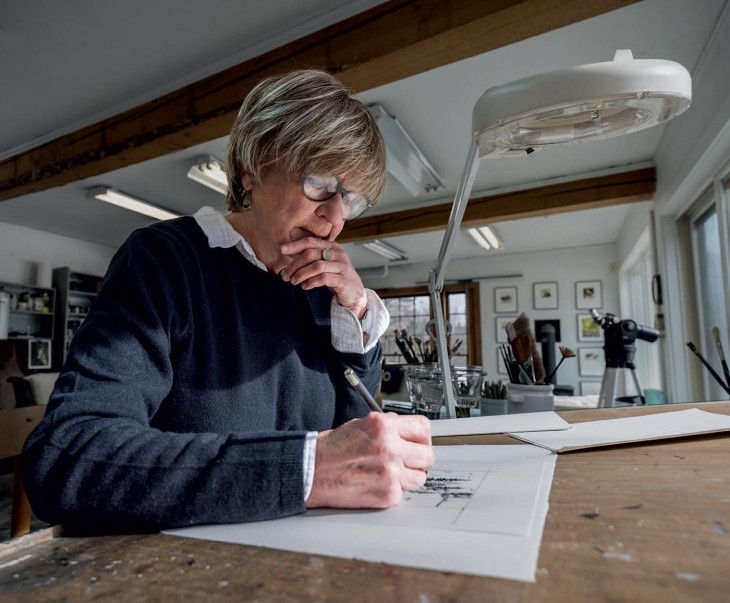
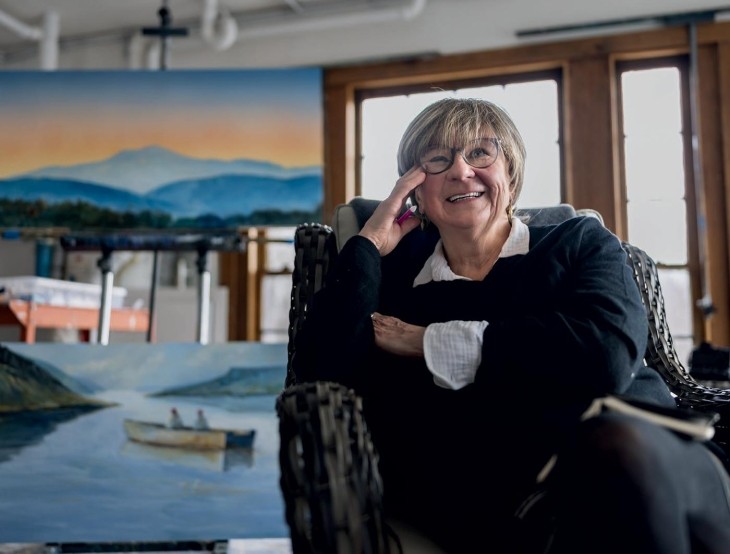
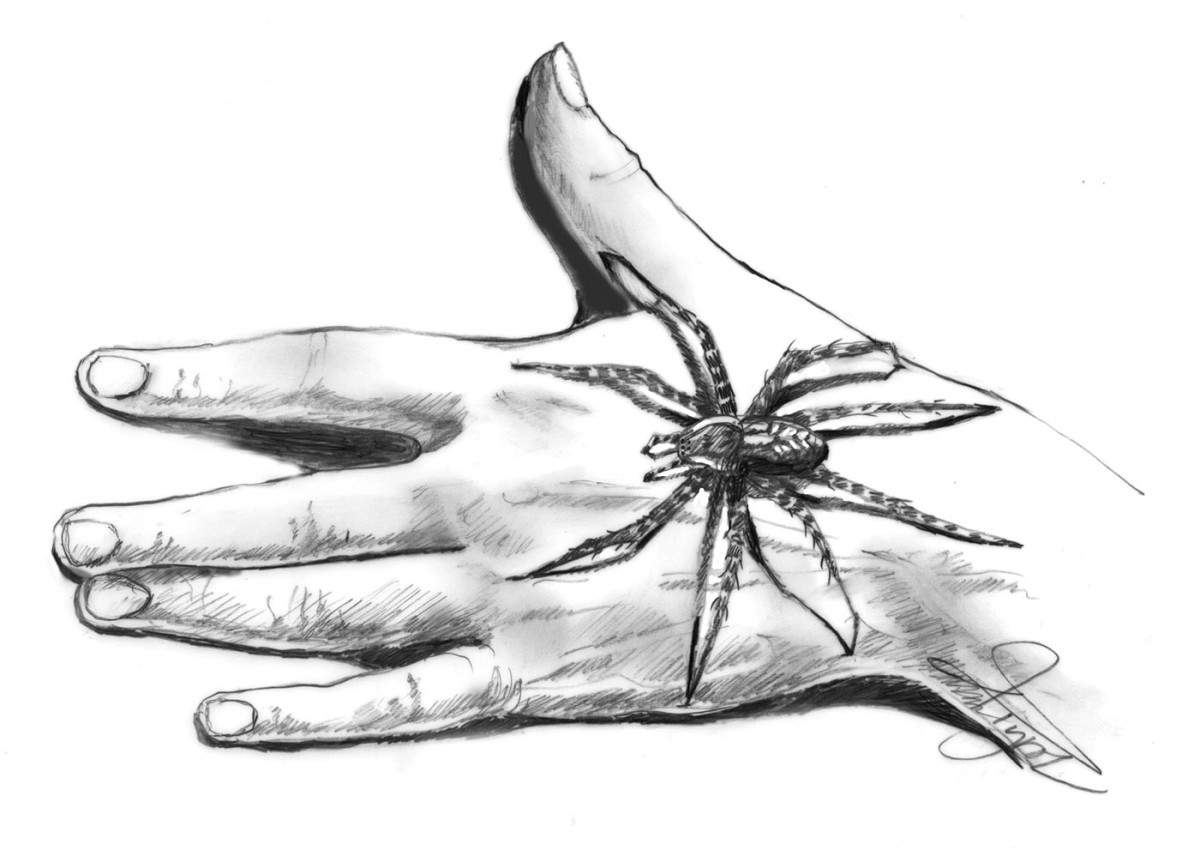
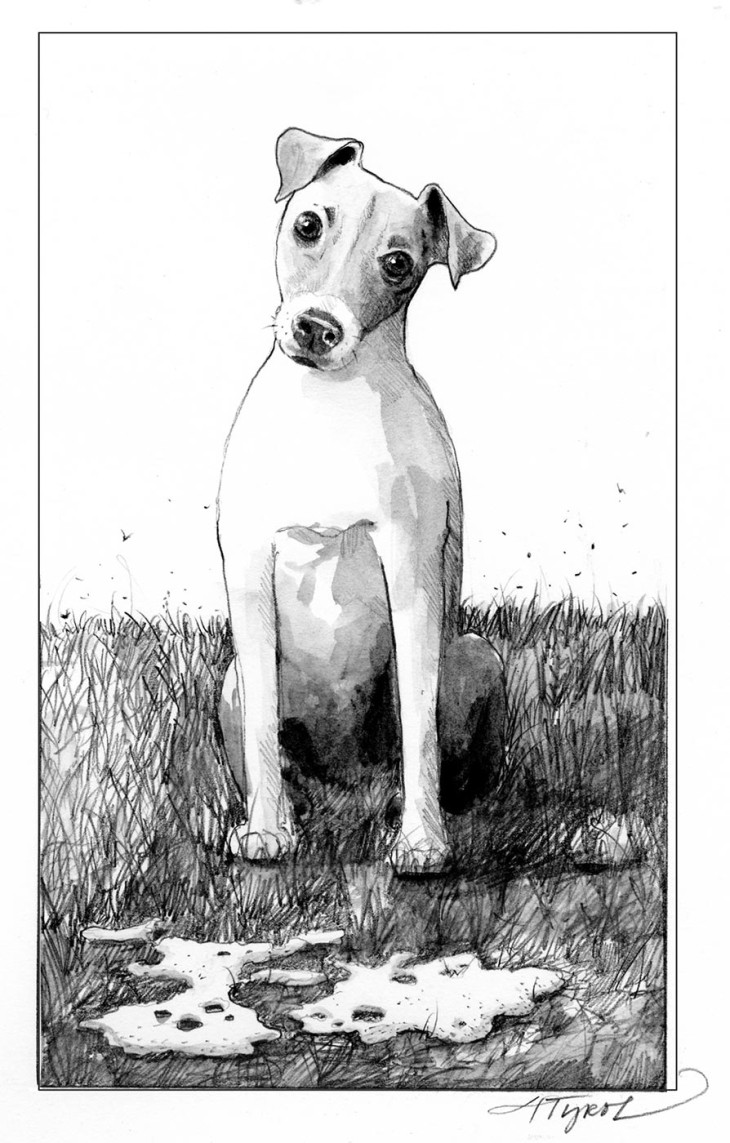
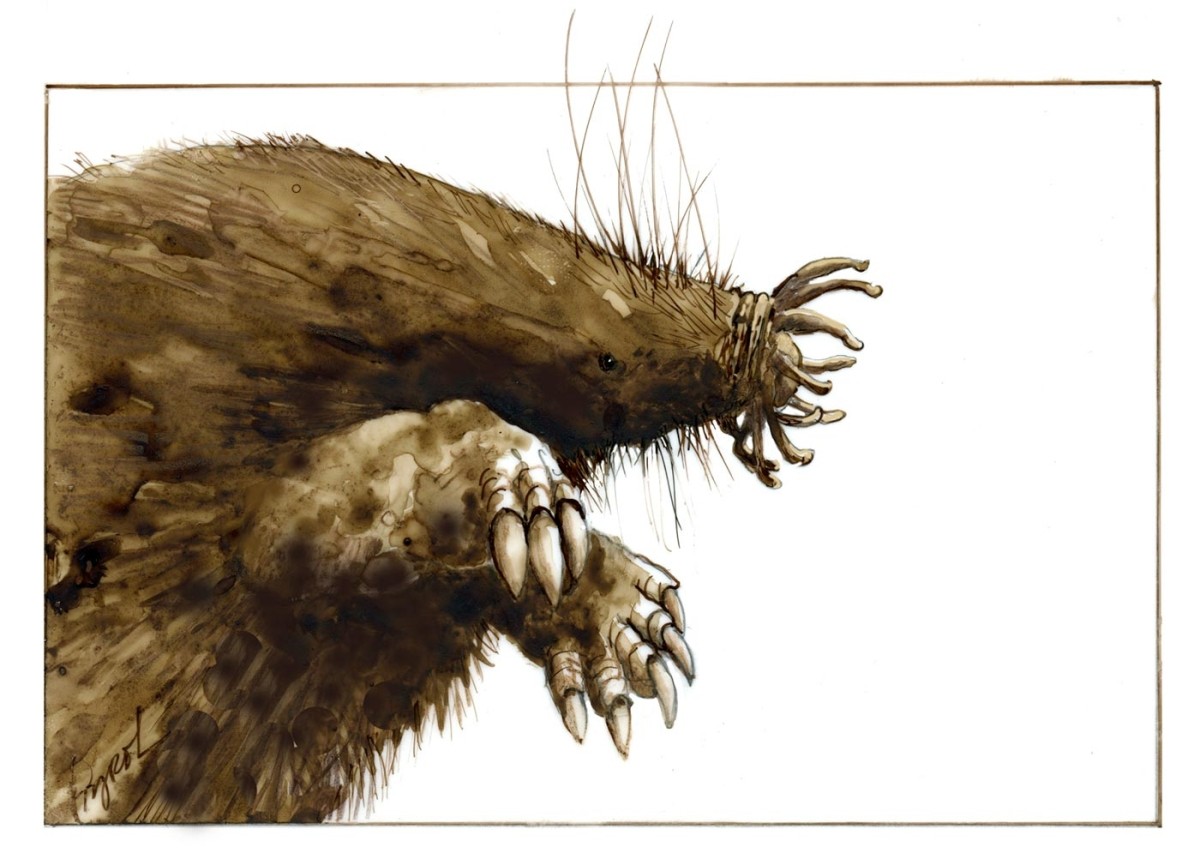
Discussion *